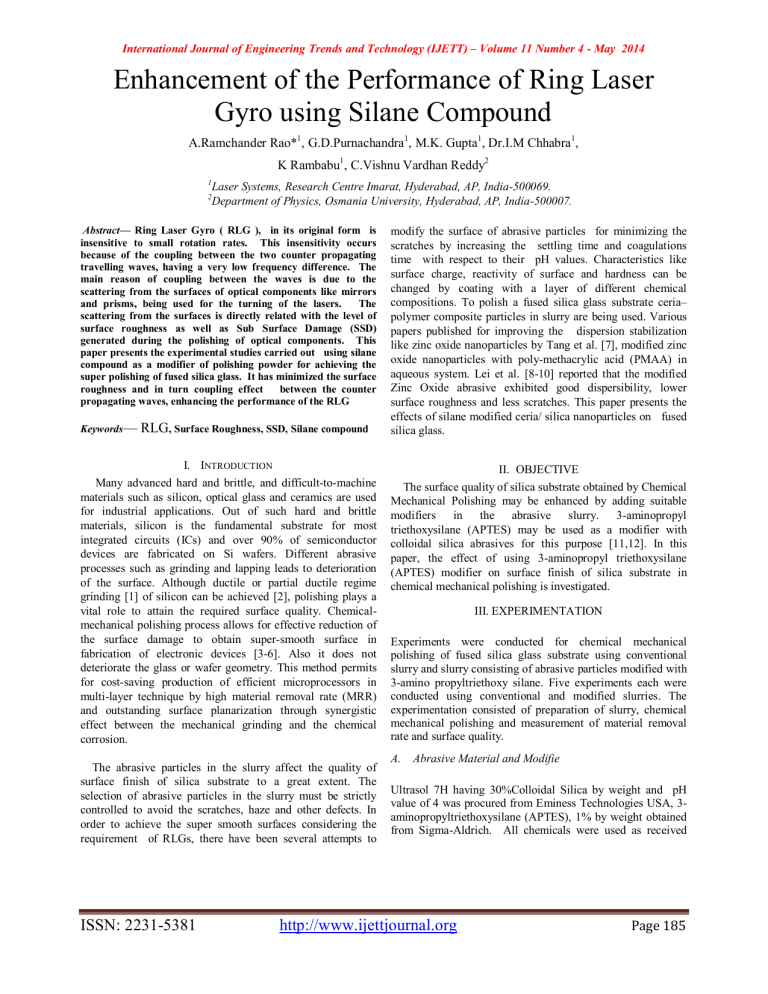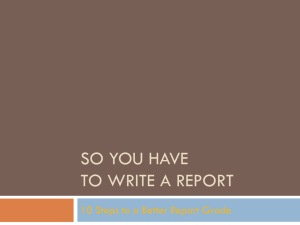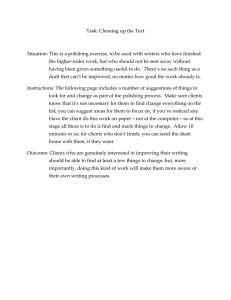Enhancement of the Performance of Ring Laser Gyro using Silane Compound

International Journal of Engineering Trends and Technology (IJETT) – Volume 11 Number 4 - May 2014
Enhancement of the Performance of Ring Laser
Gyro using Silane Compound
A.Ramchander Rao*
1
, G.D.Purnachandra
1
, M.K. Gupta
1
, Dr.I.M Chhabra
1
,
K Rambabu
1
, C.Vishnu Vardhan Reddy
2
1
Laser Systems, Research Centre Imarat, Hyderabad, AP, India-500069.
2
Department of Physics, Osmania University, Hyderabad, AP, India-500007.
Abstract— Ring Laser Gyro ( RLG ), in its original form is insensitive to small rotation rates. This insensitivity occurs because of the coupling between the two counter propagating travelling waves, having a very low frequency difference. The main reason of coupling between the waves is due to the scattering from the surfaces of optical components like mirrors and prisms, being used for the turning of the lasers. The scattering from the surfaces is directly related with the level of surface roughness as well as Sub Surface Damage (SSD) generated during the polishing of optical components. This paper presents the experimental studies carried out using silane compound as a modifier of polishing powder for achieving the super polishing of fused silica glass. It has minimized the surface roughness and in turn coupling effect between the counter propagating waves, enhancing the performance of the RLG
Keywords
— RLG
, Surface Roughness, SSD, Silane compound modify the surface of abrasive particles for minimizing the scratches by increasing the settling time and coagulations time with respect to their pH values. Characteristics like surface charge, reactivity of surface and hardness can be changed by coating with a layer of different chemical compositions. To polish a fused silica glass substrate ceria– polymer composite particles in slurry are being used. Various papers published for improving the dispersion stabilization like zinc oxide nanoparticles by Tang et al. [7], modified zinc oxide nanoparticles with poly-methacrylic acid (PMAA) in aqueous system. Lei et al. [8-10] reported that the modified
Zinc Oxide abrasive exhibited good dispersibility, lower surface roughness and less scratches. This paper presents the effects of silane modified ceria/ silica nanoparticles on fused silica glass.
I.
I NTRODUCTION
Many advanced hard and brittle, and difficult-to-machine materials such as silicon, optical glass and ceramics are used for industrial applications. Out of such hard and brittle materials, silicon is the fundamental substrate for most integrated circuits (ICs) and over 90% of semiconductor devices are fabricated on Si wafers. Different abrasive processes such as grinding and lapping leads to deterioration of the surface. Although ductile or partial ductile regime grinding [1] of silicon can be achieved [2], polishing plays a vital role to attain the required surface quality. Chemicalmechanical polishing process allows for effective reduction of the surface damage to obtain super-smooth surface in fabrication of electronic devices [3-6]. Also it does not deteriorate the glass or wafer geometry. This method permits for cost-saving production of efficient microprocessors in multi-layer technique by high material removal rate (MRR) and outstanding surface planarization through synergistic effect between the mechanical grinding and the chemical corrosion.
The abrasive particles in the slurry affect the quality of surface finish of silica substrate to a great extent. The selection of abrasive particles in the slurry must be strictly controlled to avoid the scratches, haze and other defects. In order to achieve the super smooth surfaces considering the requirement of RLGs, there have been several attempts to
II.
OBJECTIVE
The surface quality of silica substrate obtained by Chemical
Mechanical Polishing may be enhanced by adding suitable modifiers in the abrasive slurry. 3-aminopropyl triethoxysilane (APTES) may be used as a modifier with colloidal silica abrasives for this purpose [11,12]. In this paper, the effect of using 3-aminopropyl triethoxysilane
(APTES) modifier on surface finish of silica substrate in chemical mechanical polishing is investigated.
III.
EXPERIMENTATION
Experiments were conducted for chemical mechanical polishing of fused silica glass substrate using conventional slurry and slurry consisting of abrasive particles modified with
3-amino propyltriethoxy silane. Five experiments each were conducted using conventional and modified slurries. The experimentation consisted of preparation of slurry, chemical mechanical polishing and measurement of material removal rate and surface quality.
A.
Abrasive Material and Modifie
Ultrasol 7H having 30%Colloidal Silica by weight and pH value of 4 was procured from Eminess Technologies USA, 3aminopropyltriethoxysilane (APTES), 1% by weight obtained from Sigma-Aldrich. All chemicals were used as received
ISSN: 2231-5381 http://www.ijettjournal.org
Page 185
International Journal of Engineering Trends and Technology (IJETT) – Volume 11 Number 4 - May 2014 without further purification. Purified water having a water resistivity 18 M Ω cm was used. All the sample preparations were done at room temperature.
Table 1: SURFACE ROUGHNESS VALUES OBTAINED WITH
UNMODIFIED AND MODIFIED SLURRY
Unmodified
Slurry
Modified
Slurry
B.
Polishing performance test by conventional polishing
The fused silica glass of 18 x 14 x 6mm was polished using optical polishing Machine as in Fig. 1. The polishing experiments were performed on five samples. After the preliminary operation the glass substrate was subjected to final Polishing using opaline powder on polyurethane polishing pad for about eight hours. Then the glass substrate was tested for its surface roughness by 3 D non contact profiler using White Light Phase shifting Interferometry techniques with the accuracy of 0.1 nm in the Z direction to obtain R a and R z
roughness heights. The Surface roughness was measured at three different locations on each sample
(Fig.2). And the results are summarized in Table 1.
1
Roughness(Ra)
1
Location
2 3
Avg
(Ra)
Roughness(Ra)
1
Location
2 3
Avg
(Ra)
1.4 0.99 0.8 1.06 0.41 0.51 0.53 0.48
2 0.69 0.68 0.76 0.71 0.64 0.61 0.51 0.59
3 0.85 0.66 0.71 0.74 0.74 0.65 0.71 0.70
4 0.86 0.86 0.66 0.79 0.59 0.5 0.52 0.54
Fig.
1: O PTICAL P OLISHING M ACHINE
C.
Polishing performance test by modified slurry
As mentioned above the similar experiment has been carried out using the modified slurry using
APTES and the results of surface roughness is also summarized in Table.1
5 1.05 0.92 1 0.99 1.24 0.88 0.55 0.89
The surface roughness (R a
) values measured for all the five samples was lower with modified slurry than obtained by polishing using unmodified slurry. The average values of surface roughness obtained with unmodified and modified slurry are plotted in Fig.3
.
1.2
1.0
0.8
0.6
0.4
0.2
0.0
1 2
Conventional Polishing
Silane Midified Slurry
3
Samples
4 5
Fig.3
COMPARISON OF SURFACE FINISH OBTAINED WITH
CONVENTIONAL AND MODIFIED SLURRY
Fig.2
2D SURFACE PROFILE OF THE GLASS SUBSTRATE
IV.
RESULTS AND DISCUSIONS
The reasons of improvement in surface finish are investigated by observing the variations in abrasive particle properties like change in Zeta potential (using the Master sizer 3000), stabilization time of the slurry and coating onto the particle which has soften the particle.
The measured and average surface roughness values for the
ISSN: 2231-5381 http://www.ijettjournal.org
Page 186
International Journal of Engineering Trends and Technology (IJETT) – Volume 11 Number 4 - May 2014 five samples are given in Table. 1. WYCO NT 1000 Surface
Profiler was used to measure the surface Roughness (R a
) and
Peak-to-Valley value (PV) of glass substrate. Scattering which is directly proportional to average roughness value and in turn the Lock in threshold which is related with the equation below states that higher the scattering coupling coefficient, higher will be the lock in threshold. (Fig.4)
L
c
8
A rCos
Where r is the scattering coupling coefficient, c velocity of the light, A area of the cavity, wavelength of the He-Ne laser and β the Zeta potential
.
Fig.4
L
OCK
-
IN THRESHOLD MEASUREMENT WITH SILANE COMPOUND
The improved surface roughness of the glass substrate reduced the lock in threshold value which has been experimentally evaluated and shown below in Table 2.
In turn the improved performance of Ring Laser
Gyro .
Table 2 T HE L OCK IN DATA OF THE G YROS ASSEMBLED WITH SUBSTRATES
PROCESSED IN DIFFERENT FABRICATION METHODS
Process
With conventional
Polishing
With modified
Slurry polishing
Lock in threshold
0.2 deg/Sec
0.04 deg/Sec
V.
CONCLUSION
In this work, the effect of abrasive particle modifier 3APTES on surface finish of glass substrate was observed by chemical mechanical polishing. It was found that there was improvement in surface finish by modification of colloidal silica with silane when compared to conventional polishing process as the soft coating of 3- aminopropyltriethoxy silane on abrasive particles helped to decrease mechanical damage so as to improve surface quality. It improved the surface roughness and in turn lock-in; resulting in to enhancement of performance of RLG.
R EFERENCES
[1] Zhong ZW (2003) “Ductile or partial ductile mode machining of brittle materials” Int J Adv Manuf Technol 21(8):579–585
[2] Zhong ZW (2002) “Surface finish of precision machined advanced
[3] materials” J Mater Process Technol 122(2–3):173–178
S.Dominika,, Andrzej Gładki , Krystyna Mazur , Ewa Talik
“ Optimisation of the epi-ready semi-insulating gas wafer preparation procedure” Vacuum 72 (2004) 217–22
[4] K. Gottfried, I. Schubert S.E. Schulz , T. Gessner “Cu/Barrier CMP on porous low-k based interconnect schemes” Microelectronic
Engineering 83 (2006) 2218–2224.
[5] Zhu Yonghua , Pan Guoshun1 Dai Yuanjing, Luo Jianbin, Liu Yan
“Influence of slurry as ph value on chemical mechanical polishing of hard disc glass substrate” Chinese Lubrication Engineering 32 (2007)
24–27
[6] J.Z. Sun, J Z Sun, G S Pan, Y Zhou, Y H Zhu, J B Luo, X C Lu, Y Liu
“Effect of ingredients in slurry containing alumina on chemical mechanical polishing of hard disc substrate” Journal of Engineering
Tribology: Part J 223 (2009) 1003–1011.
[7] Y Tang E.J., Cheng G.X., Ma X.L., Pang X.S., Zhao Q. “Surface modification of zinc oxide nanoparticle by PMAA and its dispersion in aqueous system” Appl.Surf.Sci., 2006, v.252, iss.14, p.5227-5232.
[8] Zhang Z.F., Lei H “Preparation of a-alumina/polymethacrylic acid composite abrasive and its CMP performance on glass substrate”
Microelectronic Engineering, 2008, v.85, iss.4, p.714-720.
[9] Lei H., Lu H.S., Luo J.B., Lu X.C. Preparation of a alumina- g polyacrylamide composite abrasive and chemical mechanical polishing behavior. Thin Solid Films, 2008, v.516, iss.10, p.3005-3008.
[10] Lei H., Zhang P.Z. “ Preparation of alumina/silica core-shell abrasives and their CMP behavior “ Appl.Surf.Sci., 2007, v.253, iss.21, p.8754
8761
[11] Zhang Zefang, Yu Lei, Liu Weilia, Song Zhitang, “Surface modification of ceria nanoparticles and their chemical mechanical polishing behavior on glass substrate” Applied Surface
Science,Vol.253, Issue 11, 30 March 2007, Pages 4951–4954
[12] ZhongHua Gu, Yan Zhou, Tuo Li, Hua Gong, Yan Liu “Preparation of silane modi fied SiO2 abrasive particles and their ChemicalMechanical
Polishing (CMP) performances” Wear 273 (2011) 100–104
ISSN: 2231-5381 http://www.ijettjournal.org
Page 187





